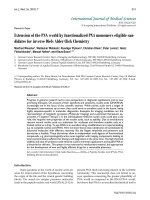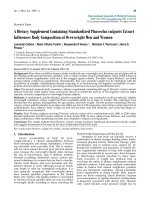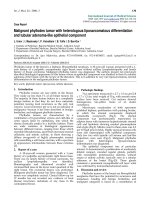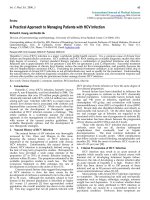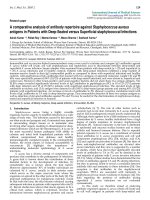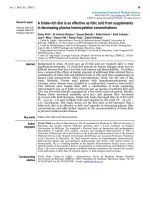Báo cáo y học: "A cyclic-RGD-BioShuttle functionalized with TMZ by DARinv “Click Chemistry” targeted to αvβ3 integrin for therapy"
Bạn đang xem bản rút gọn của tài liệu. Xem và tải ngay bản đầy đủ của tài liệu tại đây (2.39 MB, 14 trang )
Int. J. Med. Sci. 2010, 7
326
I
I
n
n
t
t
e
e
r
r
n
n
a
a
t
t
i
i
o
o
n
n
a
a
l
l
J
J
o
o
u
u
r
r
n
n
a
a
l
l
o
o
f
f
M
M
e
e
d
d
i
i
c
c
a
a
l
l
S
S
c
c
i
i
e
e
n
n
c
c
e
e
s
s
2010; 7(6):326-339
© Ivyspring International Publisher. All rights reserved
Research Paper
A cyclic-RGD-BioShuttle functionalized with TMZ by DAR
inv
“Click Chemi-
stry” targeted to α
v
β
3
integrin for therapy
Klaus Braun
1
*
, Manfred Wiessler
1
*, Rüdiger Pipkorn
2
, Volker Ehemann
3
, Tobias Bäuerle
1
, Heinz
Fleischhacker
1
, Gabriele Müller
4
, Peter Lorenz
1
, Waldemar Waldeck
4
1. German Cancer Research Center, Dept. of Imaging and Radiooncology, INF 280, D-69120 Heidelberg, Germany
2. German Cancer Research Center, Central Peptide Synthesis Unit, INF 580, D-69120 Heidelberg, Germany
3. University of Heidelberg, Institute of Pathology, INF 220, D-69120 Heidelberg, Germany
4. German Cancer Research Center, Division of Biophysics of Macromolecules, INF 580, D-69120 Heidelberg, Germany
* The authors contributed equally to this work
Corresponding author: Klaus Braun, Ph.D., German Cancer Research Center (DKFZ), Dept. of Imaging and Radiooncol-
ogy, Im Neuenheimer Feld 280, D-69120 Heidelberg, Germany. Phone: +49 6221-42 2495; Fax: +49 6221-42 3326; e-mail:
Received: 2010.07.02; Accepted: 2010.09.07; Published: 2010.09.21
Abstract
Clinical experiences often document, that a successful tumor control requires high doses of
drug applications. It is widely believed that unavoidable adverse reactions could be minimized
by using gene-therapeutic strategies protecting the tumor-surrounding healthy tissue as well
as the bone-marrow. One new approach in this direction is the use of “Targeted Therapies”
realizing a selective drug targeting to gain effectual amounts at the target site, even with
drastically reduced application doses. MCF-7 breast cancer cells expressing the α
v
β
3
[al-
p h a ( v ) b e t a ( 3 ) ] i n t e g r i n r e c e p t o r a r e c o n s i d e r e d a s a p p r o p r i a t e c a n d i d a t e s f o r s u c h a t a r g e t e d
therapy. The modularly composed BioShuttle carrier consisting of different units designed to
facilitate the passage across the cell membranes and for subcellular addressing of diagnostic
and/or therapeutic molecules could be considered as an eligible delivery platform. Here we
used the cyclic RGD-BioShuttle as a carrier for temozolomide (TMZ) at the α
v
β
3
integrin
receptor realizing local TMZ concentrations sufficient for cell killing. The IC50 values are 12
µMol/L in the case of cRGD-BioShuttle-TMZ and 100 µMol/L for underivatized TMZ, which
confirms the advantage of TMZ reformulation to realize local concentrations sufficient for cell
killing.
Our paper focuses on the design, synthesis and application of the cRGD-BioShuttle conjugate
composed of the cyclic RGD, a α
v
β
3
i n t e g r i n -ligand, ligated to the cytotoxic drug TMZ. The
ligation was carried out by the Diels Alder Reaction with inverse electron demand (DAR
inv
).
Key words: Click-Chemistry, Cycloaddition, BioShuttle, Ligation chemistry, Linker Systems,
Adaptor Systems, inverse Diels Alder Reaction, RGD, Tetrazines, targeted Therapy, Temozolomide
Introduction
Breast cancer is one of the most common malig-
nancies affecting women in developed countries.[1]
Approximately three out of four women with breast
cancer develop metastases in bone which, in turn,
diminish the quality of life.[2] An optimal treatment
concept for patients needs different therapy modali-
ties and methods with an optimum in efficiency and
the greatest possible protection. Attention should be
Int. J. Med. Sci. 2010, 7
327
laid on an individual and not just standardized plan
of treatment for every single patient and all available
therapy options should be used, such as immunothe-
rapy, surgery or chemotherapy sensibly using cytos-
tatic active agents with acceptable adverse reactions.
It is remarkable how dated medical treatment me-
thods are persistently continued [reported during the
“International Brain Tumor Research Conference 2010
(
Toxic side effects are documented for TMZ as
adverse reactions in the bone-marrow. Moreover, it is
known from clinical experience, that even higher ap-
plication doses are necessary for successful tumor
control. This approach seems obsolete now, because
’Targeted Therapy’ has reached the focus of scientific
interest in order to minimize such unavoidable drastic
side effects. Strategies were discussed during the
aforementioned meeting to protect the bone-marrow,
e.g. with gene-therapeutic methods. Another inter-
esting field is the regional chemotherapy in which
cytostatic drugs are being locally applied to certain
body regions. The topical application increases the
amount of active substances in the tumor and im -
proves efficiency, while lowering the side effect rate at
the same time.
However, many cell immanent obstacles inhibit
chemical therapy, such as the multidrug resistance
(MDR) mediated against cytotoxic agents like TMZ,
and apoptosis resistance with disruption of the com-
plex programmed cell death pathway network. The
Janicke group documented apoptosis resistant MCF-7
breast cancer cells treated with ionizing radiation,
however especially breast micro-metastases are diffi-
cult to determine and even more difficult to treat ef-
fectively.
Therefore only a selective targeting of the drug
can deliver an effectual amount of TMZ to its target
site, even with drastically reduced application doses.
How to perform this is exemplarily shown here by
targeting and controlling breast cancer cells.
Our considerations to overcome these resis-
tance-inducing factors led to the application of li-
gands, which are target-specific for cell-typical sur-
face receptors, as described as follows.
On these cells the α
v
β
3
[alpha(v)beta(3)] and α
v
β
5
[alpha(v)beta(5)]integrins are heterodimeric cell sur-
face receptors which mediate adhesion between cells
and the extracellular matrix.[3] The α
v
β
3
receptor has
previously been implicated in a key role of tumor
progression, metastasis and osteoclast bone resorp -
tion. [4] Integrins, the corresponding ligands, are
evolutionarily old and have critical roles during de-
velopmental and pathological processes. The antibo-
dies to α
v
β
3
integrin and its antagonists like
arg-gly-a s p (R G D)-containing peptides, including
osteopontin, bone sialoprotein, vitronectin and fibri-
nogen are considered as efficient inhibitors which can
control the tumor progression.[5]
This α
v
β
3
integrin receptor is documented as an
outstanding target in the field of tumor imaging [6-8]
and is equally important as a chemotherapeutic target
in the field of targeted therapy.[9]
Endocytosis-mediated intracellular trafficking of
ligands via the α
v
β
3
receptor of MCF-7 cells and the
α
v
β
5
integrin receptor into the perinuclear region of
HeLa cells is documented, which lack the functional
α
v
β
3
receptor.[10] Interestingely HeLa cells, which
express the α
v
β
3
integrin receptor at low level, possess
lower invasive potential than MCF-7 cells. In our ex-
periments we used MCF-7 human breast cancer cells
and HeLa cervix cancer cells to investigate the new
cRGD-BioShuttle as a delivery platform for targeting
with TMZ in order to realize high local TMZ concen-
trations at the MCF-7 and HeLa cell’s surfaces and,
after uptake into the cells sufficient for cell killing.
This paper intends to summarize the major ef-
forts reached thus far and focuses on the design,
synthesis and application of the
cRGD-BioShuttle-TMZ conjugate. The whole mole-
cule was synthesized via Diels Alder Reaction with
inverse electron demand. It is composed of the cyclic
RGD-containing the α
v
β
3
and α
v
β
5
integrin antagonist
cRGD.
Cell culture
The estrogen sensitive MCF-7 adenocarcinoma
breast cancer and HeLa cervix cancer cells (dkfz, tu-
morbank) were maintained at 37°C in a 5% CO
2
at -
mosphere in RPMI cell medium (Gibco, Germany)
supplemented with 5% fetal calf serum (Biochrome,
Germany). The cells were split twice a week.
Chemical Procedures
Synthesis of the RGD-BioShuttle
Derivatization of temozolomide
N-(2-Aminopropyl)-4-(6-(pyrimidine-2-yl)-1,2,4,5-tetrazine-3-yl)be
nzamide 4
4-(6-(Pyrimidine-2-yl)-1,4-dihydro-1,2,4,5-tetrazi
ne-3-yl)benzoic acid (3) was prepared from
2-cyanopyrimidine 1 a nd 4 -cyano-ben zoic ac id 2 by
reaction with hydrazine and then oxidized with so-
dium nitrite to the tetrazine derivative 4 according to
the following procedure [11]. The tetrazine derivative
was converted with thionyl chloride under standard
conditions to the chloride 5. To this suspension of the
acid chloride (2 mmol) in 20 ml CH
2
C l
2
a solution of
Int. J. Med. Sci. 2010, 7
328
N-Boc-1,3-diaminopropane (2 mmol) and TEA (2
mmol) in 10 ml CH
2
C l
2
was slowly added at 0-5°C.
The resulting solution was deeply coloured and
maintained for 4 h at room temperature. Then the
organic phase was washed with water, followed by
1N HCl and again water. The organic layer was dried
over Na
2
SO
4
and evaporated. The resulting residue
was chromatographed on silica gel by elution with
chloroform/ethanol (9:1) and further purified by re-
crystallization from acetone. Yield: 50 to 70 % de-
pending on the quality of the carboxylic acid. ESI MS:
m/z 437.2 [M]
+
. The Boc-protected derivative was
treated with TFA (5 ml) for 30 min at room tempera-
ture and isolated by evaporation to a solid residue (6)
(ESI: m/z 337.2 [M]
+
(as shown in Figure A).
Figure A shows the mass of the
N-(2-Aminopropyl)-4-(6-( py ri mi di ne-2-yl)-1,2,4,5-tetrazine
-3-yl )b en za m i de ( 6 i n s c heme 1 /Figure S1), as discussed by
Wiessler [12].
3-Methyl-4-oxo-3,4-dihydroimidazo[5,1-d][1,2,3,5]tetrazine-8-carb
oxylic acid chloride 7
3-Methyl-4-oxo-3,4-dihydroimidazo[5,1-d][1,2,3,
5]tetrazine-8-carboxylic acid was converted to the
corresponding chloride 7 as documented by Ar-
rowsmith [13]. The acid (2 mmol) was refluxed with
thionyl chloride (10 ml) until the acid was completely
dissolved. The excess of thionyl chloride was evapo-
rated under vacuum and the resulting solid was
stored over NaOH.
3-Methyl-4-oxo-N-(3-(4-(6-(pyrimidine-2-yl)-1,2,4,5-tetrazine-3-y l )
benzamido)propyl)-3,4-dihydroimidazo[5,1-d][1,2,3,5]tetrazine-
8-carboxamide (TMZ-tetrazine diene) 9
Compound 8 (0.5 mmol) and the chloride 7 (0.5
mmol) were dissolved in 5 ml chloroform and 5 ml
TEA at 0-5 °C. After 4 h at room temperature, the so -
lution was washed with water, 1 N HCl and again
with water. The organic layer was dried over Na
2
SO
4
and evaporated. The residue was purified by chro-
matography (silica gel) with chloroform/ethanol
(9.5/0.5). Yield: 68%: ESI: m/z 536.3 [M+Na]
+
. (Figure
B)
Figure B shows the mass of
3-methyl-4-o xo -N-(3-(4-(6-(pyrimidine-2-y l) -1,2,4,5-tetrazi
ne-3-yl)benzamido)propyl)-3,4-di h y dr oi mi daz o [5 ,1 -d][1,2,3
,5]tetrazine-8-carboxamide {TMZ-tetrazine diene (9 in
scheme 1/F i g u r e S 1 )} [12].
Derivatizations of the cRGD
Synthesis of the Reppe anhydride 12
The t
etrac
yclo-[5.4.2
1,7
.0
2,6
.0
8,11
]3,5-diox o-4-aza-
9,12-t
ridecadiene (Reppe-anhydride) 12 was prepared
f r o m 4 2 m g o f ( 1 Z , 3 Z , 5 Z , 7 Z ) -cycloocta-1,3,5,7-tetraene
10 and 44 mg maleic anhydride 11 in chloroform as
documented by Reppe [14].
Int. J. Med. Sci. 2010, 7
329
Figure S1 (Scheme 1) the nitriles 1 and 2 react with hydrazine to the 4-(6-(pyrimidine-2-yl)-1,4-dihydro-
1,2,4,5-tetrazine-3-yl)benzoic acid 3. Oxidation to 4 and reaction with thionyl chloride result in the corresponding acide
c h l o r i d e 5 w h i c h r e a c t s w i t h N-Boc-1,3-diaminopropane to the product 6. Boc-deprotection and subsequent reaction with
3-Methyl-4-ox o-3,4-dihydroimidazo[5,1-d][1,2,3,5]tetrazine-8-carboxylic acid chloride 7 result in the product
3-Methyl-4-ox o-N-(3-(4-(6-(pyrimidine-2-y l) -1,2,4,5-tetrazin-3-y l) b en za mi do ) pr op yl ) -3,4-dihydroimidazo[5,1-d][1,2,3,5]tet
razine-8-carboxamide (TMZ-tetrazine diene) 9.
Figure S2 (Scheme 2) illustrates the chemical reaction of (1Z,3Z,5Z,7Z)-cycloocta-1,3,5,7-tetraene 10 and 44 mg maleic
anhydride 11 which produces the t
etrac
yclo-[5.4.2
1,7
.0
2,6
.0
8,11
]-3,5-d i ox o-4-aza-9,12-t
ri de ca di en e 14 (NMH data of 12 are
shown in the F i g u r e C .
Int. J. Med. Sci. 2010, 7
330
Figure C shows the
1
H-NMR-spectrum of the Reppe
Anhydride {TcT = (T
etrac
yclo-[5.4.2
1,7
.O
2,6
.O
8,11
]
3,5-di ox o-4-aza-9,12-t
ridecadiene in CDCl
3
}
.
The structure
describes the shift calculation for protons of the compound
with ChemDraw Ultra 2004. (Numbers indicate the pre-
dicted shift of the signals in ppm, as discussed by Wiessler
[12].
Synthesis of the dienophile cRGD-Lys(Tct) (14)
3 0 µ m o l c R G D p e p t i d e ( 1 8 m g ) 13 and 40 µm o l ( 8
mg) t
etrac
yclo-[5.4.2
1,7
.0
2,6
.0
8,11
]3,5-d ioxo-4-aza-9,12-
t
ridecadiene 12 were dissolved in pyridine over 5
hours at 70° - 80°C. Yield: 6 mg 14. Empirical formula
C39H49N9O9; exact Mass: 787.37 Mol. Wt.: 787.86
m/e: 787,37 (100,0%), 788,37 (43,1%), 789,37
(12,3%), 788,36 (3,3%), 790,38 (1,2%), 790,37 (1,1%) C,
59.45; H, 6.27; N, 16.00; O, 18.28 m/e peak at 788.5 for
the product.
L i g a t i o n o f t h e c R G D -L y s ( T c t ) w i t h t h e T M Z -tetrazine 9
Equimolar amounts of the TMZ-tetrazine con-
jugate 9 (1.03 mg; 2 µmol) and cRGD-Lys(Tct) 14 (7.3
mg, 2 µmol) were dissolved in aqueous solution and
stored at room temperature for 24 h. The DAR
inv
re-
action occurs at room temperature and was completed
after the colour changed from magenta to yellow. The
product 15 (cRGD-BioShuttle-TMZ) was isolated by
lyophilization; yield: 98 %); MS ESI: m/e 1634.8; cal-
culated C
81
H
9 1
N
19
O
15
S
2
1633.6.
Figure S3 (Scheme 3) shows the DAR
inv
reaction of the diaryl-tetrazine harbouring TMZ 9 with cRGD functionalized with
the Reppe Anhydride 14 to the product 15 (cRGD-BioShuttle-TMZ).



